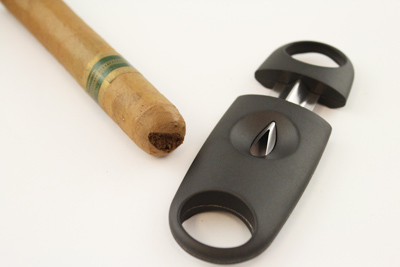Cigar 101: Anatomy and Cutting
The act of enjoying a cigar to is a path that is often filled with misconceptions and error. While it may seem easy to cut, light, and smoke a cigar, there are subtleties to the routine that can ensure a pleasant smoking experience. This post is the first in a series that will cover the basics of enjoying a cigar. The series will cover the basics of cutting, lighting, and smoking cigars, as well as proper storage of cigars. While it may seem elementary, performing these steps properly can make all the difference between liking a cigar and loving a cigar.
The first step to enjoying a cigar starts with knowing the anatomy of a cigar. Cigars are constructed of three basic parts; the filler, binder, and wrapper. The filler is the inner most, and largest, portion of the cigar, while the binder is the portion that holds all of the filler leaves together. These two parts combined form what is called a bunch. Once the bunch is constructed then the wrapper is placed on the cigar. The wrapper is considered to be the most important part of the cigar because it is the what the smoker sees and touches. Aside from enticing the smoker with its appearance, the wrapper also generates a majority of the cigar’s flavor. Once the cigar is constructed, it consists three main parts; the head, the body, and the foot. The head is the top of the cigar that is sealed with a cap; the body is the portion that will be smoked; and the foot is the bottom potion that will be ignited.
Cutting, which is the next step to enjoying a cigar, may seem like a simple act, but it is an act that people often perform incorrectly. A common mistake made by cigar smokers is cutting past the cap, into the head of a cigar. Cutting into the head of a cigar is a terrible mistake because it can often result in a cracked wrapper, which can lead to an uneven burn.
The easiest way to ensure that only the cap is removed is to place the cutter on a level surface, such as a table, place the head of the cigar into the cutter, and cut it. Cutting a cigar in this manner will ensure that only the cap is removed from the cigar.
If the cigar is a figurado, like a torpedo, then the table cutting method will not work. For these types of cigars there are two options. The head can either be cut straight across, or at an angle. Cutting the head straight across is a perfectly fine, but may result in resin build up, which can lead to a difficult draw and bitter taste. Cutting the cigar at an angle between 35 and 45 degrees will provide a larger surface area, which will provide an easier draw.
The quality and type of the cutter used on a cigar is also important to ensure a clean and even cut. Single guillotine cutters will cut from just one side of the head. As long as the blade is sharp it will provide a clean cut, once the blade begins to dull, the cutter runs the risk of crushing the cigar and cracking the wrapper. Double guillotine cutters and cigar scissors cut the cigar from both sides. These cutters have cresent shaped blades that will disperse the pressure evenly over the head better than a single guillotine cutter, which normally uses an angled blade.
Aside from guillotine cutters and cigar scissors, which remove the entire cap, punch cutters and v-cutters only remove a portion of the cap. When using a punch cutter it is important to consider the ring gauge of the cigar. If the ring gauge around 54-60 it is best to use a larger punch (9mm) to ensure a great draw. If the cigar has a smaller ring guage it is best to use a smaller punch (7mm). The quality of the punch cutter is also very important.
If the blade of the punch cutter is dull then it runs the risk of cracking the wrapper of the cigar. When using a punch cutter it is important to remember to rotate the cutter while putting pressure on the cap. Using a punch cutter in this manner creates a sawing motion that cuts into the cap and puts less pressure on the cigar.
V-cutters cut in a manner similar to single guillotine blades, but only create a knotch in the cap of the cigar. In order for this type of cut to be done properly, the blades must be sharp.
Quality cutters are availiable from a variety of companies. For example, Xikar provides a great line of cutters that include a lifetime warrenty. If the cutter begins to dull, Xikar will either sharpen the blades or replace the cutter free of charge. Colibri also makes outstanding cutters that will provide an accurate cut every time. These cutters are great for avid cigar smokers who smoke on a daily basis. For the weekend smoker, a cutter from Craftsman’s Bench will be perfect since it will not be used on a daily basis. All of these cutters are available at our five store locations as well as emersonscigars.com.
The style of cutter used is totally up to the smoker. It’s all a matter of preference, some smokers will only use punch cutters, while others will only use double guillotine cutters. The important thing is that the smoker finds the type of cutter they enjoy the most. Knowing what makes a cigar and how to properly cut a cigar is just the first step to enjoying a cigar. The next step is lighting the cigar, which will be explained in the next intsallment of Cigar 101.














